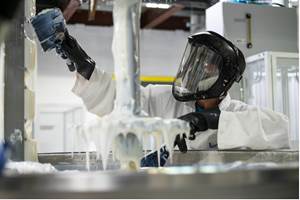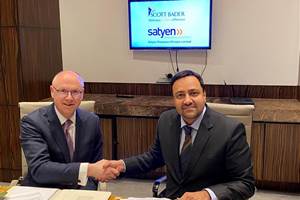Plant Tour: Aeris Energy — Wind blade economics
Side story to Plant Tour: Aeris Energy, Caucaia, Brazil.
One result of Aeris Energy’s close relationship with resin supplier Hexion Inc. (Columbus, OH, US) is that the wind blade manufacturer has embraced much of the latter’s strategic and operational thinking. Hexion’s wind energy and composites team, led by Johannes Meunier, Hexion’s global segment leader, wind/composites, has been a steady, influential presence at Aeris almost from its start.
Meunier and his team, based out of Germany, have a long history with composite materials, composites manufacturing and the wind energy industry. Because of this, he has seen good and efficient as well as bad and inefficient composites manufacturing. In short, he has firm opinions about what it takes to maximize efficiency, quality and profitability in the wind blade manufacturing space.
Meunier notes, first, that the wind blade manufacturing industry has matured substantially in the past decade. Product quality standards have tightened, material quality has improved, manufacturing processes have been fine-tuned, blade architecture has evolved, average blade length has increased, and blade lifespan expectations also have increased — to 25 years. Unchanged, however, is the fact the blade is the bottleneck in the overall wind turbine manufacturing process. Blademakers, therefore, are under constant pressure to increase the pace of manufacture, without failing to meet quality and cost targets. Compounding this challenge is the famous Square-Cube Law, which says:
- Wind turbine power is proportional to the square of rotor diameter, and . . .
- Wind blade mass increases in proportion to the rotor diameter cubed.
What does this mean? Wind blade mass increases at a greater rate than wind turbine power as rotor diameter increases.
Meunier has a few simple rules for coping in this environment. First, emphasize quality and value over unit price. Or more simply, you get what you pay for.
Second, and conversely, don’t choose materials based on low unit price. Very often, Meunier says, the use of a more expensive, higher quality material (glass, resin, bonding paste) can provide long-term savings that exceed the additional cost of the material.
Third, he says, capture data. Good manufacturers value map — that is, they measure every manufacturing activity and know intimately what it costs in money, personnel and time to manufacture a blade. Among the things to measure: In-mold repairs, raw material cost and waste, resin used vs. resin disposed of, blade manufacturing time, man-hours/blade, cycle time, kitting accuracy.
Fourth, continuously improve. Use your captured data to feed a continuous effort to increase manufacturing speed and workflow without increasing personnel costs. Look for wasted time, effort, material and money, and then work to get rid of it. “The customers that see that potential are the most successful customers,” Meunier contends. “You cannot achieve such savings by pushing down on unit price. You must innovate the cost out.”
This philosophy is expressed clearly at Aeris in many ways — in how the company manages its workforce, cares for its molds, carries out production, and positions itself in the marketplace. “We do not make the least expensive blades,” admits Bruno Lolli, Aeris’ planning and process management director. “That is not how we compete. But we make quality blades, and we focus on serving the customer. We feel we are in a very good place.”
Related Content
Scott Bader ATC begins Crestabond MMA structural adhesive production
Scott Bader’s Drummondville, Canada, facility has begun manufacturing and supplying composites-applicable adhesives to its North American customers.
Read MoreScott Bader acquires Satyen Polymers, enhances commitment to Indian customers
Under the agreement, India-based Scott Bader Pvt. Ltd. will assume responsibilities for direct sales and marketing for all resin and gelcoat products, bring composites and adhesives to Indian market.
Read MoreXlynX Materials BondLynx and PlastiLynx for low surface energy PP, PE substrates
Award-winning Xlynx materials use breakthrough “diazirine” technology to boost bond strength up to 950% as adhesives, primers and textile strengtheners.
Read MoreMaterials & Processes: Resin matrices for composites
The matrix binds the fiber reinforcement, gives the composite component its shape and determines its surface quality. A composite matrix may be a polymer, ceramic, metal or carbon. Here’s a guide to selection.
Read MoreRead Next
Composites end markets: Energy (2024)
Composites are used widely in oil/gas, wind and other renewable energy applications. Despite market challenges, growth potential and innovation for composites continue.
Read MoreFrom the CW Archives: The tale of the thermoplastic cryotank
In 2006, guest columnist Bob Hartunian related the story of his efforts two decades prior, while at McDonnell Douglas, to develop a thermoplastic composite crytank for hydrogen storage. He learned a lot of lessons.
Read MoreCW’s 2024 Top Shops survey offers new approach to benchmarking
Respondents that complete the survey by April 30, 2024, have the chance to be recognized as an honoree.
Read More


























